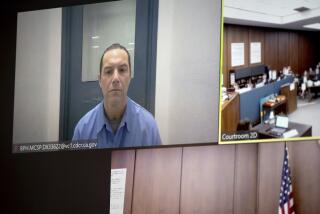Spector lawyers urge state appellate court to throw out murder conviction
- Share via
Lawyers for imprisoned music producer Phil Spector urged a state appellate court this week to throw out his conviction for the murder of an actress in his Alhambra mansion.
In papers filed Wednesday, attorneys for the music legend cited a number of grounds on which justices from the 2nd District Court of Appeal should grant the 70-year-old a new trial.
But they focused on a judge’s decision to allow testimony from five women who claimed Spector menaced them with firearms in the decades leading up to Lana Clarkson’s shooting.
Those accounts, which portrayed Spector as a violent misogynist, became “the heart of the state’s case, the sine qua non of its efforts to gain a conviction” and amounted to impermissible character testimony, the lawyers wrote.
A Superior Court jury found Spector guilty last year of second-degree murder in the 2003 slaying of Clarkson. He is serving a sentence of 19 years to life in prison.
Judge Larry Paul Fidler told the jury that the testimony of the women could be evidence that Clarkson’s death from a single gunshot wound to her mouth was not the result of a mistake, accident or, as Spector’s defense contended, suicide, but not evidence that he had a propensity to commit crimes.
Spector’s lawyers argued that the judge undercut his admonition by allowing prosecutors to use the word “pattern” more than 40 times in their summations to describe the producer’s conduct with women and guns.
“Asserting that a defendant has a ‘pattern’ of violent conduct is indistinguishable from arguing that he or she has a propensity or character trait for violence,” wrote lawyers Dennis Riordan, Donald Horgan and Charles Sevilla.
The state attorney general’s office is to file a response next month, but a decision could be more than a year away.
The case file sent to the appellate court for review includes transcripts from two trials -- the first in 2007 ended in a hung jury -- and is more than 18,000 pages long.
harriet.ryan @latimes.com
More to Read
The biggest entertainment stories
Get our big stories about Hollywood, film, television, music, arts, culture and more right in your inbox as soon as they publish.
You may occasionally receive promotional content from the Los Angeles Times.











